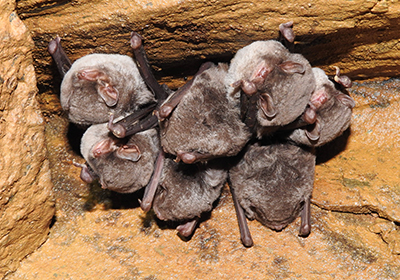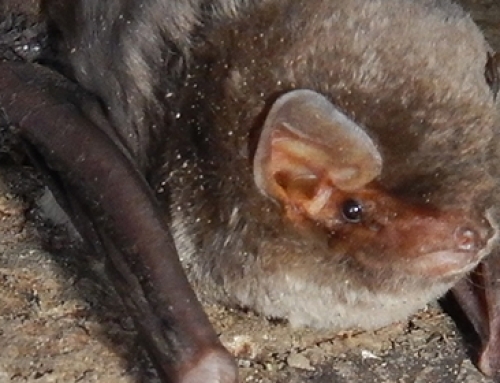
Towards the end of June 2020, a cat from Arezzo, Central Italy, was diagnosed with a rare case of infection by Lyssavirus. The virus was promptly isolated from a sample of the animal’s brain by the National Reference Centre for Rabies of the Istituto Zooprofilattico Sperimentale delle Venezie (IZSVe), and identified as West Caucasian Bat Lyssavirus (WCBV). To date WCBV had been identified only once, in 2002, in a bat in the Russian part of the Caucasus. WCBV is differs from the classic rabies virus.
Towards the end of June 2020, a cat from Arezzo, Central Italy, was diagnosed with a rare case of infection by Lyssavirus, a genus composed of 17 species, including the rabies virus. The animal died of a neurological disease consistent with rabies, after biting its owner and several veterinarians, but fortunately without further consequences for other animals and persons living in the area.
The virus was promptly isolated from a sample of the animal’s brain by the National Reference Centre for Rabies of the Istituto Zooprofilattico Sperimentale delle Venezie (IZSVe), and identified as West Caucasian Bat Lyssavirus (WCBV). How did the story evolve?
The silent journey of West Caucasian Bat Lyssavirus
To date WCBV had been identified only once, in 2002, in a bat in the Russian part of the Caucasus. WCBV is differs from the classic rabies virus. However, in infected animals it causes the same clinical disease, manifesting with anomalous aggressiveness, as in the case of the cat from Arezzo.
Clearly, therefore, isolation of the virus in Italy – the world’s second case – was in itself a rather rare occurrence. The real “scientific dilemma,” however, was to determine the dynamics of the jump (spillover) from the original host, likely a bat, to the cat. During the pandemic, a time when bats were under close scrutiny by the scientific community, it was no secondary issue. A year later, following in-depth investigation, researchers were able to confirm the bat origin of the virus and to piece together the spillover mechanism between the two animal species, as described in a work published in the scientific journal, Viruses.
The miniopterus bat tunnel

The epidemiological investigation focused firstly on exploring the possibility that an interface between cats and bats might be present in the area. Eventually, an approximately 2-km-long tunnel covering an underground river was located close to the cat’s house, where a group of common bent-winged bats (Miniopterus schreibersii) was discovered. This was the same species of bat in which the virus had been detected almost twenty years previously in Russia.
The epidemiological investigation focused firstly on exploring the possibility that an interface between cats and bats might be present in the area, using visual observation, bioacoustic analyses, and camera trapping to determine bats’ places of roosting. Besides IZSVe, the task force of experts also included the IZS of Lazio and Tuscany, the STERNA Cooperative for Ecological Studies and Natural and Environmental Research, the Region of Tuscany, the Local Health Authority AUSL Toscana SudEst of Arezzo, and the Italian Ministry of Health.
Eventually, an approximately 2-km-long tunnel covering an underground river was located close to the cat’s house. Starting from August 2020, the tunnel was periodically inspected up to twice per month, until the discovery of a group of common bent-winged bats (Miniopterus schreibersii) belonging to a population ranging in number from 40 to 425, depending on the season. This was the same species of bat in which the virus had been detected almost twenty years previously in Russia. The same population roosts in the area only at certain times of the year, between April and June and then again in August and October, and is now under close surveillance.
To establish whether other species of bat besides bent-winged ones were present in the area, the multidisciplinary team analysed the ultrasounds emitted by the bats – classified as echolocation calls, feeding buzzes, and social calls. This also enabled them to identify Pipistrellus kuhlii and Hypsugo savii bats (species commonly found in Italian cities) and other more sporadic species. However, bats were not the only visitors to the tunnel, as revealed by the images taken by the camera traps located at the two tunnel entrances: cats, hedgehogs, and birds were all captured on film, as were… three people!

What the case of the cat from Arezzo tells us is that after 18 years and at a distance of over 2,000 km, viruses continue to circulate in silence and, under the right conditions, occasionally come out of hiding. The real challenge now is to investigate the reasons why bent-winged bats moved so close to the city, as this species is instead used to living in caves and to feeding in open spaces.
Meanwhile, four samplings were carried out over the same period to determine the age, sex, and physiological status of the animals and to collect blood (190) and saliva (268) to screen for the virus and antibodies. The results of the laboratory analyses showed that the bats in this colony had virus-neutralizing antibodies to WCBV, but no virus in salivary swabs. Conversely, the carcasses of other bat species were all negative for both virus and antibodies. Lastly, genetic analyses revealed that the viral genome of WCBV isolated in Arezzo was very similar to the reference isolate from the Russian bat identified in 2002.
What do we learn from the cat from Arezzo?
Our knowledge of WCBV is based on a rather small case set, but, as a lyssavirus, all control and surveillance measures required to avoid further infections were promptly deployed with respect to people and animals. What the case of the cat from Arezzo tells us is that after 18 years and at a distance of over 2,000 km, viruses continue to circulate in silence and, under the right conditions, occasionally come out of hiding.
The real challenge now is to investigate the reasons why bent-winged bats moved so close to the city. This species is instead used to living in caves and to feeding in open spaces. Which is why its presence in Arezzo was such a surprise, but warmly welcomed by a predator like a cat, posing a potential risk for public health and bat conservation. As has already occurred in other settings, these animals may have moved following modification or destruction of their natural habitat by humans, making us the real triggers of the spillover.
Read the scientific article on Viruses »






